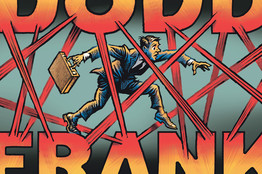Four Years of Dodd-Frank Damage
< < Go Back
By Peter J. Wallison,
The financial law has restricted credit and let regulators create even more too-big-to-fail companies.
When the Dodd-Frank Wall Street Reform and Consumer Protection Act took effect on July 21, 2010, it immediately caused a sharp partisan division. This staggeringly large legislation—2,300 pages—passed the House without a single Republican vote and received only three GOP votes in the Senate. Republicans saw the bill as ObamaCare for the financial system, a vast and unnecessary expansion of the regulatory state.
Four years later, Dodd-Frank’s pernicious effects have shown that the law’s critics were, if anything, too kind. Dodd-Frank has already overwhelmed the regulatory system, stifled the financial industry and impaired economic growth.
According to the law firm Davis, Polk & Wardell’s progress report, Dodd-Frank is severely taxing the regulatory agencies that are supposed to implement it. As of July 18, only 208 of the 398 regulations required by the act have been finalized, and more than 45% of congressional deadlines have been missed.
The effect on the economy has been worse. A 2013 Federal Reserve Bank of Dallas study showed that the GDP recovery from the recession that ended in 2009 has been the slowest on record, 11% below the average for recoveries since 1960.
There is always a trade-off between regulation and economic growth, but Dodd-Frank—by far the most intrusive and costly financial regulation since the New Deal—placed few if any limitations on regulatory power. Written broadly and leaving regulators to fill in the details, the act has often left regulators in doubt about what Congress meant. Even after regulations have been finalized, interpreting them can be a trial. For example, the regulations implementing the inconsistent Volcker Rule, which prohibited banks and their affiliates from trading securities for their own account, took more than three years to write, but key provisions are still unclear.
These uncertainties, costs and restrictions have sapped the willingness or ability of the financial industry to take the prudent risks that economic growth requires. With many more regulations still to come, Dodd-Frank is likely to be an economic drag for many years.
None of this was necessary. The administration and Congress acted hastily. The Treasury Department sent draft legislation to Congress only a few months after taking office in 2009, and the law—spurred by a promise from then-Rep. Barney Frank for a “new New Deal”—passed a year later. The left’s view had been settled: the crisis would be blamed on Wall Street greed and insufficient regulation. The act set out to implement that worldview by subjecting American finance to unprecedented government control.
It is now clear, however, that government housing policies—implemented primarily by Fannie Mae FNMA -3.00% and Freddie Mac FMCC -2.10% —forced a reduction in mortgage underwriting standards, which was the real cause of the crisis. The goal was to foster affordable housing for low-income and minority borrowers, but these loosened standards inevitably spread to the wider market, building an enormous housing bubble between 1997 and 2007.
By 2008 roughly 58% of all U.S. mortgages—32 million loans—were subprime or otherwise low quality. Of these 32 million loans, 76% were on the books of government agencies, primarily Fannie and Freddie, showing incontrovertibly where the demand for these loans originated. When the housing bubble burst, mortgage defaults soared to unprecedented levels. Although the left’s narrative placed all blame on the private sector, these numbers show that private firms were responsible for less than a quarter of the problem.
Yet Dodd-Frank said nothing about government housing policies and ignored Fannie and Freddie. It focused on placing additional restrictions on financial firms, often for no apparent purpose other than to extend government control.
More From The Wall Street Journal (subscription required):




